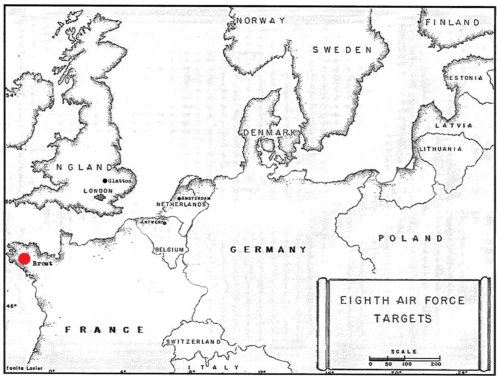TARGET: ENEMY STRONG POINTS
BREST, FRANCE
11 AUGUST, 1944
The mission of the day was flown by twenty-three combat wings of the Eighth Air Force, on targets including marshalling yards and fuel dumps in northeastern France, and air fields and fuel dumps in the Pans area.
The 457th attacked B rest, one of the few remaining strong points held by the enemy in the Brest Peninsula. The Group, forming the 94th C Wing, was third on the target and first on the MPIs, a trio of defended areas including a heavy coastal battery. The destruction of this defensive unit was desired by allied ground and naval forces ringing the port.
Three twelve-aircraft boxes were dispatched by the 457th. The team of Major Smith and Captain Clarence E. Schuchmann led the formation.
The route both to and from the target was over water the majority of the time. The IP was in the sea southwest of the peninsula’s tip. Crossing the entrance to Brest harbor in clear weather, the Wing made a visual bomb run and dropped bombs from 25,000 feet.
Flak was meager and not very accurate, but the aircraft piloted by Lt. Gerald B. Ross was hit in No. 3 and No.4 engines. It left the formation about ten minutes later near the north coast of the peninsula. They began losing altitude and Lt. Ross determined that the plane could not get back to England. He began trying to find a landing strip. Only one was found and it was full of craters. The fields in the countryside were not suitable for a crash landing; consequently Lt. Ross ordered the crew to bail out.
The entire crew successflully parachuted to the earth. Lt. Ross was approached by a farmer holding a pitchfork. Lt. Ross identified himself as an American airman and the farmer told Lt. Ross he was in No Man’s Land. He was taken to a nearby town where he was greeted by a group of French patriots. Lt. Ross and crew were later taken to the Allied VIII Corps Headquarters near St. Malo, France, and ultimately returned to England. For the rest of the Group, the route back to the base was without incident.
On 11 August special instructions were received for procedures to follow in the event an aircraft were damaged and a crash landing were to be attempted, or the crew ordered to bail out near the front lines of the ground war. It was the Command’s belief that, if the procedure were followed, there would be a very high probability of safe landing in Allied territory.
